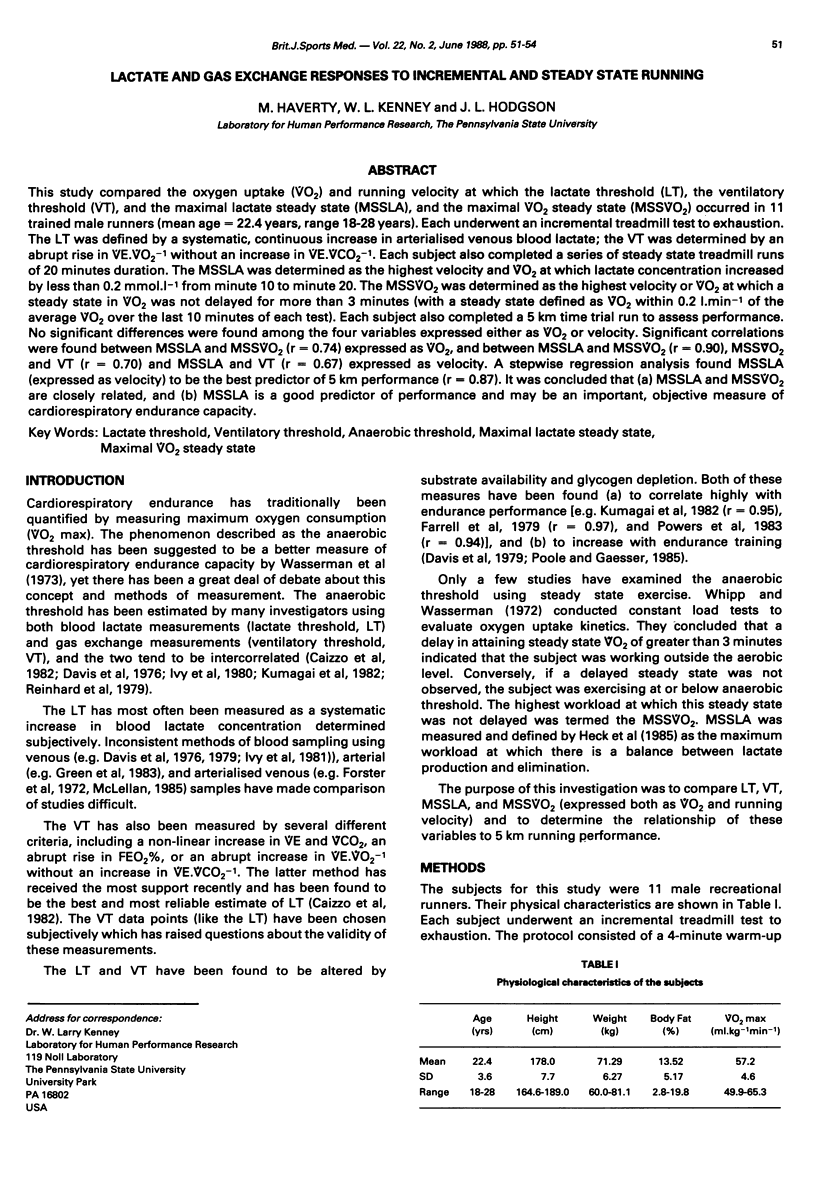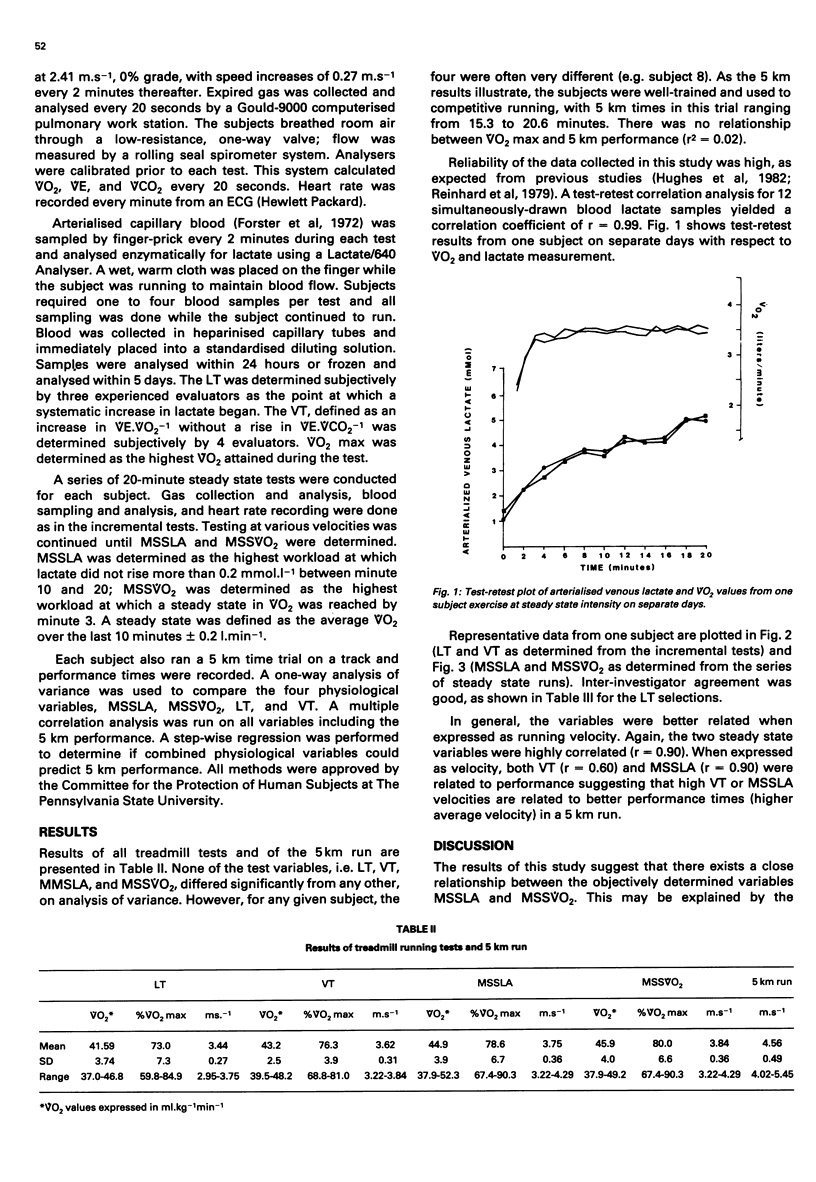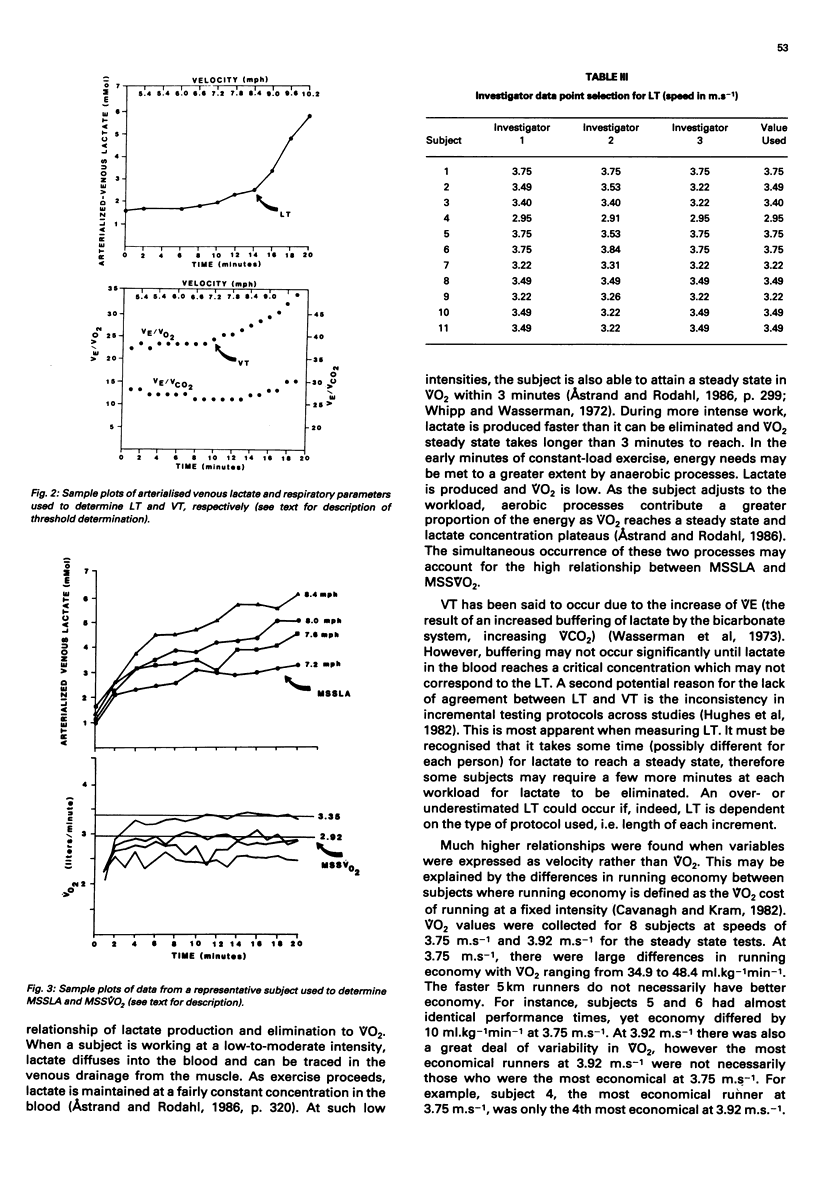Abstract
This study compared the oxygen uptake (VO2) and running velocity at which the lactate threshold (LT), the ventilatory threshold (VT), and the maximal lactate steady state (MSSLA), and the maximal VO2 steady state (MSSVO2) occurred in 11 trained male runners (mean age = 22.4 years, range 18-28 years). Each underwent an incremental treadmill test to exhaustion. The LT was defined by a systematic, continuous increase in arterialised venous blood lactate; the VT was determined by an abrupt rise in VE.VO2(-1) without an increase in VE.VCO2(-1). Each subject also completed a series of steady state treadmill runs of 20 minutes duration. The MSSLA was determined as the highest velocity and VO2 at which lactate concentration increased by less than 0.2 mmol.l-1 from minute 10 to minute 20. The MSSVO2 was determined as the highest velocity or VO2 at which a steady state in VO2 was not delayed for more than 3 minutes (with a steady state defined as VO2 within 0.2 l.min-1 of the average VO2 over the last 10 minutes of each test). Each subject also completed a 5 km time trial run to assess performance. No significant differences were found among the four variables expressed either as VO2 or velocity. Significant correlations were found between MSSLA and MSSVO2 (r = 0.74) expressed as VO2, and between MSSLA and MSSVO2 (r = 0.90), MSSVO2 and VT (r = 0.70) and MSSLA and VT (r = 0.67) expressed as velocity. A stepwise regression analysis found MSSLA (expressed as velocity) to be the best predictor of 5 km performance (r = 0.87). It was concluded that (a) MSSLA and MSSVO2 are closely related, and (b) MSSLA is a good predictor of performance and may be an important, objective measure of cardiorespiratory endurance capacity.
Full text
PDF



Selected References
These references are in PubMed. This may not be the complete list of references from this article.
- Caiozzo V. J., Davis J. A., Ellis J. F., Azus J. L., Vandagriff R., Prietto C. A., McMaster W. C. A comparison of gas exchange indices used to detect the anaerobic threshold. J Appl Physiol Respir Environ Exerc Physiol. 1982 Nov;53(5):1184–1189. doi: 10.1152/jappl.1982.53.5.1184. [DOI] [PubMed] [Google Scholar]
- Cavanagh P. R., Kram R. The efficiency of human movement--a statement of the problem. Med Sci Sports Exerc. 1985 Jun;17(3):304–308. [PubMed] [Google Scholar]
- Davis J. A., Frank M. H., Whipp B. J., Wasserman K. Anaerobic threshold alterations caused by endurance training in middle-aged men. J Appl Physiol Respir Environ Exerc Physiol. 1979 Jun;46(6):1039–1046. doi: 10.1152/jappl.1979.46.6.1039. [DOI] [PubMed] [Google Scholar]
- Davis J. A., Vodak P., Wilmore J. H., Vodak J., Kurtz P. Anaerobic threshold and maximal aerobic power for three modes of exercise. J Appl Physiol. 1976 Oct;41(4):544–550. doi: 10.1152/jappl.1976.41.4.544. [DOI] [PubMed] [Google Scholar]
- Farrell P. A., Wilmore J. H., Coyle E. F., Billing J. E., Costill D. L. Plasma lactate accumulation and distance running performance. Med Sci Sports. 1979 Winter;11(4):338–344. [PubMed] [Google Scholar]
- Forster H. V., Dempsey J. A., Thomson J., Vidruk E., DoPico G. A. Estimation of arterial PO2, PCO2, pH, and lactate from arterialized venous blood. J Appl Physiol. 1972 Jan;32(1):134–137. doi: 10.1152/jappl.1972.32.1.134. [DOI] [PubMed] [Google Scholar]
- Green H. J., Hughson R. L., Orr G. W., Ranney D. A. Anaerobic threshold, blood lactate, and muscle metabolites in progressive exercise. J Appl Physiol Respir Environ Exerc Physiol. 1983 Apr;54(4):1032–1038. doi: 10.1152/jappl.1983.54.4.1032. [DOI] [PubMed] [Google Scholar]
- Heck H., Mader A., Hess G., Mücke S., Müller R., Hollmann W. Justification of the 4-mmol/l lactate threshold. Int J Sports Med. 1985 Jun;6(3):117–130. doi: 10.1055/s-2008-1025824. [DOI] [PubMed] [Google Scholar]
- Hughes E. F., Turner S. C., Brooks G. A. Effects of glycogen depletion and pedaling speed on "anaerobic threshold". J Appl Physiol Respir Environ Exerc Physiol. 1982 Jun;52(6):1598–1607. doi: 10.1152/jappl.1982.52.6.1598. [DOI] [PubMed] [Google Scholar]
- Ivy J. L., Costill D. L., Van Handel P. J., Essig D. A., Lower R. W. Alteration in the lactate threshold with changes in substrate availability. Int J Sports Med. 1981 Aug;2(3):139–142. doi: 10.1055/s-2008-1034600. [DOI] [PubMed] [Google Scholar]
- Ivy J. L., Withers R. T., Van Handel P. J., Elger D. H., Costill D. L. Muscle respiratory capacity and fiber type as determinants of the lactate threshold. J Appl Physiol Respir Environ Exerc Physiol. 1980 Mar;48(3):523–527. doi: 10.1152/jappl.1980.48.3.523. [DOI] [PubMed] [Google Scholar]
- Kumagai S., Tanaka K., Matsuura Y., Matsuzaka A., Hirakoba K., Asano K. Relationships of the anaerobic threshold with the 5 km, 10 km, and 10 mile races. Eur J Appl Physiol Occup Physiol. 1982;49(1):13–23. doi: 10.1007/BF00428959. [DOI] [PubMed] [Google Scholar]
- McLellan T. M. Ventilatory and plasma lactate response with different exercise protocols: a comparison of methods. Int J Sports Med. 1985 Feb;6(1):30–35. doi: 10.1055/s-2008-1025809. [DOI] [PubMed] [Google Scholar]
- Poole D. C., Gaesser G. A. Response of ventilatory and lactate thresholds to continuous and interval training. J Appl Physiol (1985) 1985 Apr;58(4):1115–1121. doi: 10.1152/jappl.1985.58.4.1115. [DOI] [PubMed] [Google Scholar]
- Reinhard U., Müller P. H., Schmülling R. M. Determination of anaerobic threshold by the ventilation equivalent in normal individuals. Respiration. 1979;38(1):36–42. doi: 10.1159/000194056. [DOI] [PubMed] [Google Scholar]
- Stegmann H., Kindermann W., Schnabel A. Lactate kinetics and individual anaerobic threshold. Int J Sports Med. 1981 Aug;2(3):160–165. doi: 10.1055/s-2008-1034604. [DOI] [PubMed] [Google Scholar]
- Wasserman K., Whipp B. J., Koyl S. N., Beaver W. L. Anaerobic threshold and respiratory gas exchange during exercise. J Appl Physiol. 1973 Aug;35(2):236–243. doi: 10.1152/jappl.1973.35.2.236. [DOI] [PubMed] [Google Scholar]
- Whipp B. J., Wasserman K. Oxygen uptake kinetics for various intensities of constant-load work. J Appl Physiol. 1972 Sep;33(3):351–356. doi: 10.1152/jappl.1972.33.3.351. [DOI] [PubMed] [Google Scholar]


